Mustang region, the land of wonders is a superb attraction for trekking and tours. This mysterious region has a lot to offer and its history, amazing landscapes and highly enriched culture makes this region worth visiting. Upper Mustang, also known as a ‘Mini Tibet of Nepal’ and been described as “Mountain Desert". Upper mustang trek begins from Jomsom and ends at Lo-Manthang, and the journey passes through various Tibetan Buddhist settlements, surprising, tree-less landscapes, rocky trails and views of Nilgiri, Annapurna, Dhaulagiri and other Himalayas.

The trek to upper mustang begins with a scenic flight of about 20 minutes from Pokhara to Jomsom. Jomsom, being the district headquarter of Mustang District is quite a busy place. Jomsom is popular for its fiercy wind at the mid-day. After the flight, a walk through the banks of Kaligandaki River of about 2 hours takes us to Eklebhatti and walking further takes us to Kagbeni which is at an altitude of 2800m. Kagbeni village is almost all Tibetan and prayer flags are hung everywhere. Majestic views of sunrise and sunset of Mt. Nilgiri can be seen from Kagbeni.
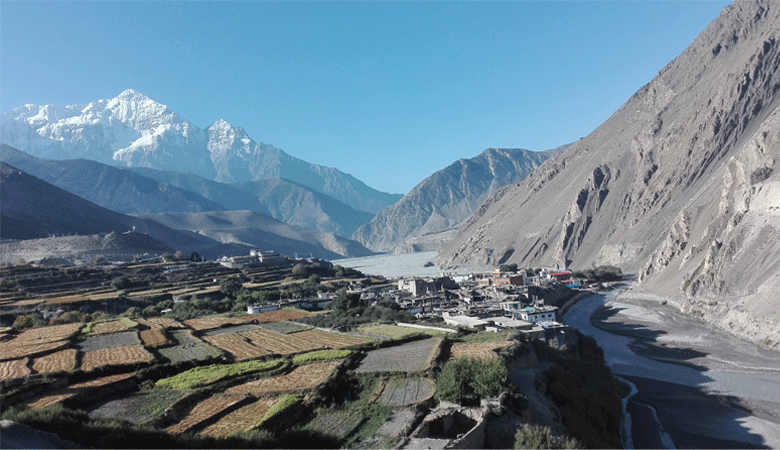
The next day after an early breakfast we head towards Chaile. From Kagbeni the trail leads up towards the east bank of the Kaligandaki climbing over few ridges and reach Chussang village. We will then cross a river and climb up to huge red mass of Conglomerate that had fallen from the cliff above, forming a tunnel through which Kali Gandaki flows. The trek now leaves the Kaligandaki valley and we will head west into the Ghyakar Khola valley .Then we will steep climb up a rocky gully to reach the village of Chaile. On the 3rd day, the trek goes along a steep barren land, alongside the copper red canyon. We will make a gradual ascent to some Chortens on a ridge, and after walking downhill for some time we will reach Samar, a beautiful village. From there, we will climb a ridge and walk down into a giant gorge. We will continue our trek through another valley, fields, cross a stream and climb up a ridge. Again we will climb another pass, go through another ridge. After a short walk, we reach to Chungsi cave, which along with the structures, statues are believed to be naturally built and then trek uphill to Syangbochen and spend overnight there.
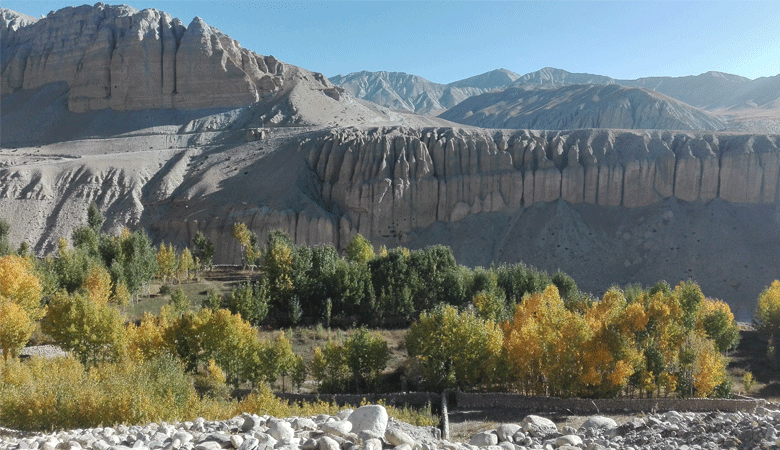
On the 4th day we will trek to Charang through Ghami. On reaching Ghami we stop for lunch and hike up. It will be a tough trek in this rough terrain. However, on reaching there we will be rewarded with magnificent views of the remote countryside and Rocky Mountains in all directions .Charang is one of the driest part of Mustang. After spending overnight at Charang, we head towards the capital of Mustang on the 5th day. Lo-Manthang, the capital of Mustang is the major attraction center of this trek. As we reach Lo-Manthang at noon, we will have lunch and take some rest. After taking some rest, we explore the walled city of Lo. Lying on the border with Tibet, Upper Mustang manifests a distinctively Tibetan culture.
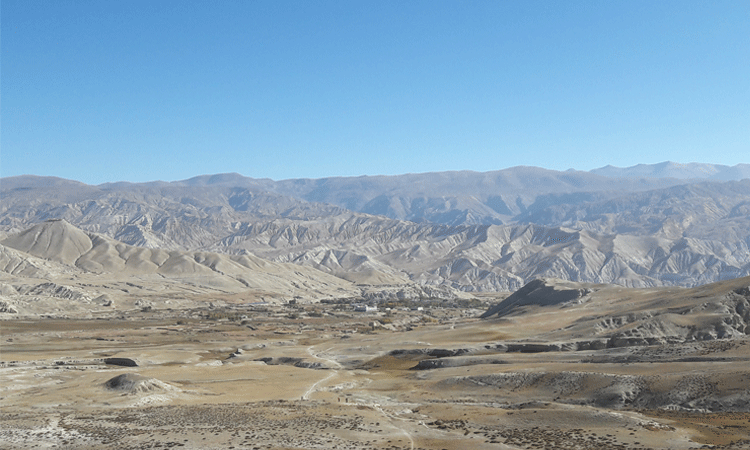
We can visit the ancient temple, monasteries of the region and the periphery of the king’s impressive palace. We can visit the 3 major monasteries of the walled city built in the 13th, 14th and 15th century. The first king of Lo, Ame Pal built Choede monastery in the 13th century and is the main Sakya monastery of Lo Manthang. Choede monastery was destroyed by earthquake in the 16th century and was rebuilt. The Jampa Monastery is the oldest Sakya monastery inside the Walled City of Lo-Manthang. It was built in early 14th century during the reign of the famous King Angon Sangpo (the second son of Ame Pal). The three storied Jampa Gonpa exemplifies Lo-Manthang's rich architectural traditions and sacred art. The uniqueness of Jampa Gonpa is demonstrated in the 108 ancient mandalas of various sizes painted in gold and silver and encrusted with turquoise, coral and gemstones. Thupchen Gonpa was built during the period of the third king of Lo, Tashi Gon in late 15th century. In its heyday, Thupchen Gonpa was the major center of all religious activities in Lo-Manthang. The entrance room (Sgo-Mchog) displays four larger-than-life images of the four directions (Gyal-Chen Shi), all enshrined upon raised platforms. We can visit The Monastic Museum which was established in 2008 by the Student Welfare Committee of Monastic School at Choede Gonpa of Lo-Manthang. It was established with the aim of preserving old and precious objects from different monasteries throughout Upper Mustang. The Museum contains different colorful masks of varying sizes that the monks of Choede Gonpa wear during traditional ritual dance programs. In the Monastic Museum, one may catch a glimpse into the traditional lifestyle of the Mustangi people. And the Museum has another attraction; the million year old tooth of a mammoth. If we manage to go to Lo Manthang around March/April, we can have the privilege to observe Tiji festival. Tiji festival is held annually for three days from the 27th of the 3rd lunar month onward according to Tibetan calendar. Tiji mask dance can also be observed during this festival which is the typical dance of Sakya tradition of Tibetan Buddhism. Tiji festival is celebrated for the sake of peace and prosperity of the Kingdom of Lo and the whole world.
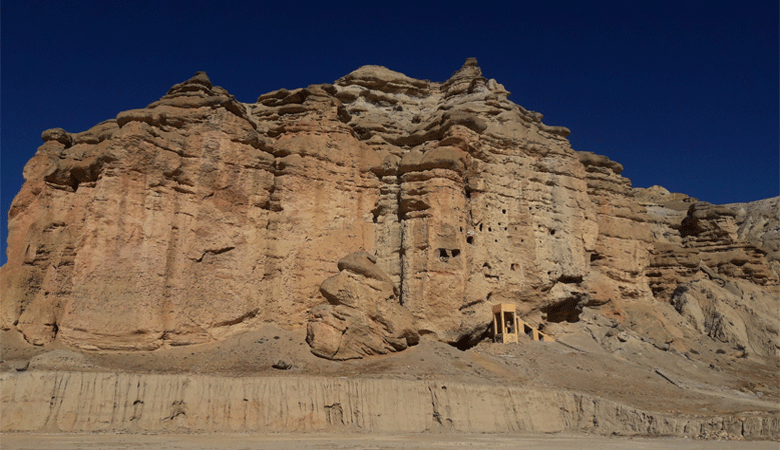
As one day is not enough to explore Lo Manthang, we will spend another day here. We can either hike or take a jeep or hire a horse to Chhoser as a part of exploration of Lo Manthang. We can observe the Chhoser Cave which is believed to be built by the ancient peoples digging on the cliffs. We can enter and go up to the 4th story inside the cave. After exploring Chhoser, we return back to Lo-Manthang and spend another night there.
On the 7th day we trek to Dhakmar via Ghar Gumba. From Lo-Manthang we walk up to a hill, and then descend down to Ghar Gumba. Ghar Gumba, believed to be built in the 7th century is the oldest monastery of the region. After exploring Ghar Gumba, we again ascend up to a hill and then walk down to Dhakmar.

On reaching Dhakmar we can enjoy the stunning views of the copper red canyons and the marvelous cliffs.On the 8th day, we descend down to Samar via Ghami followed by Syangbochen. After spending a night at Samar, we head back to Chussang on the 9th day. On the 10th day, we can either take a jeep to Muktinath temple and head towards Jomsom on the same jeep or trek to Jomsom enjoying the view of Kali Gandaki Valley and Kagbeni Village, the gateway to Mustang. An early flight back to Pokhara from Jomsom marks the end of the Upper Mustang Trekking.
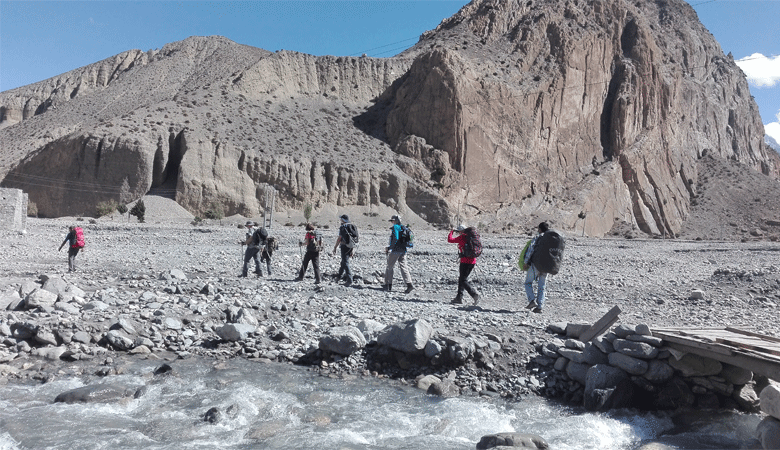
Upper Mustang trekking is something else and completely different trekking destination compared to other trekking destinations in Nepal. For an explorer, this region can be fascinating trekking destination full of mysteries and wonders.



